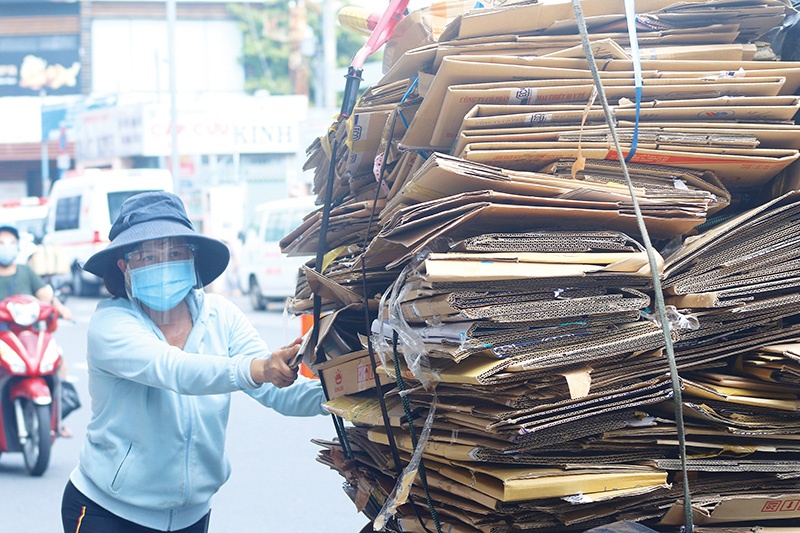Inequality changes forcing fresh gender-related policy
 |
| Women are being disproportionally more affected by pandemic impacts than men, Photo Le Tien |
Le Dieu Anh is in a deserted Hanoi park with her two sons, watching them play happily on the swings and slides, but there is no smile coming from the mother’s mouth. All she can think about is the yearning she has to return to work.
Dieu Anh used to work in human resources at a technology company in Cau Giay district, but had to leave her job entirely last May when schools shut down due to social restrictions.
“I cannot send my children anywhere, and no kindergarten is running, so I had to give up my job to take care of them. My husband does not want to lose his job, and my parents are too old to help us. I miss my job and my colleagues so much,” she said.
In nearby Tay Ho district, Vu Thi Ngan used to be a teacher in the kindergarten next to her house, but has not been able to work for nearly a year. Ngan has had to stay at home and cannot apply for any job even though she has 10 years of experience working in kindergartens. Housework and taking care of her 12-year-old daughter are her only tasks now.
“I am upset because I have stayed at home for too long. Getting acquainted with housework and forgetting the experience of working in kindergartens each day make me worried that I will never be able to apply for another job,” said Ngan.
According to the Country Gender Equality Profile Vietnam 2021 from the International Labour Organization (ILO), one of the most visible effects of the pandemic on labour markets across the world, including Vietnam, has been a reduction in working hours, including the forced reduction of daily hours of paid work, job rotation, furlough, and job losses.
Vietnam’s workers have faced a severe reduction in working hours, especially women. Lower labour force participation was a determinant of the reduction in working hours in the second quarter, with larger numbers of women than men leaving the labour force, increasing Vietnam’s gender participation gap. Women’s participation dropped by 4.8 and 2.6 percentage points in the second and third quarters of 2020, while men fell 3.9 and 1.4 percentage points only, according to the ILO.
“Another reason behind the reduction in working hours is an increase in female unemployment, while male unemployment remained stable,” said Valentina Barcucci, an economist for ILO Vietnam. In the second quarter of 2020, Vietnam had 120,000 more unemployed women than in the last quarter of 2019, while 1.8 million more women were classed as inactive.
“Although levels of female unemployment remained relatively moderate, the pandemic has generated a gap in unemployment to the disadvantage of women, which was not there beforehand,” added Barcucci.
Double burden
Nguyen Ngoc Linh, who works at a communication company in Hanoi’s Hai Ba Trung district, feels lucky to have a job. However, juggling the role along with housework is becoming a near-impossibility. Every morning, Linh wakes up at 6am to go to the market, cook breakfast, and prepare lunch.
“I usually get to work late and have been penalised millions of VND each month because of this. I cannot concentrate on my work fully, because I have to carefully look after the children from the office. I feel so stressed and overloaded over the last few months while they study from home,” said Linh.
She has to go home every lunchtime despite the distance of about 7km, and leaves the office in the evening earlier than the regulations to have enough time to cook dinner, do all the housework, and check the children’s homework. “My husband does very little housework, while we cannot hire a helper to keep the children safe from coronavirus,” added Linh.
According to the ILO, women on average spend more than twice as many hours as men doing housework. These include activities such as cleaning the house, washing clothes, cooking, shopping, and childcare. In addition, almost all women spend about 20-30 hours on these activities on a weekly basis, while a much lower proportion of men do, and close to 20 per cent of men reported they do not spend any time at all.
“The pandemic has been erasing all the achievements of narrowing gender gaps, not only exacerbating existing inequalities but also creating new ones, making the double burden on women even more onerous,” said Khuat Thu Hong, director of the Institute for Social Development Studies (ISDS).
“At the root of the labour market and gender inequalities, there is the traditional role that women are expected to play, perpetuated by both socio-cultural norms as well as by the country’s legislation,” explained Hong. “In fact, women in all sectors earn less than men, up to 22 per cent in some sectors. They are more likely to work for less in exchange for more secured and flexible jobs since it’s widely and culturally believed that the responsibilities for family housekeeping are in women’s hands.”
Multi-dimensional measures
Oxfam says that uncounted in GDP, women devote more than five hours a day to household tasks while their male partners spend a third less. So policies focusing on growth can magnify the role of men rather than women in the midst of the already-existing gender discrimination problems.
“Women are supporting the market economy with cheap and free labour and they are also supporting the state by providing care that should be provided by the public sector,” said a representative of Oxfam in Vietnam. This organisation has calculated that women’s unpaid care work alone is adding value to the economy to the tune of at least $10.8 trillion a year, a figure three times larger than the tech industry.
Therefore, Hong from the ISDS recommended the governments to pay for eldercare and childcare, or pay women who are doing most of the work a fair wage, as well as highlight their contribution to their family and to socioeconomic development.
To support women, the ILO recommended formulating social assistance, social protection, relief and recovery packages based on the analysis of the gender-differentiated impacts of the pandemic, as well as promoting and replicating strong gender-responsive practices.
In order to support workers to deal with both work and family during the pandemic, the French government allowed those who needed to stay at home to take care of their children to enjoy preferential treatment, and 70 per cent of people registered for this policy are women.
In Vietnam, the Ministry of Labour, Invalids, and Social Affairs has already proposed several solutions to recover the labour market, including directly giving employees a cash amount, training and improving skills, and connecting demand and supply. To help women and reduce the gender gap, the ministry has proposed to deliver an amount for women’s startups, which is being considered and approved by the National Assembly.
“Without supporting women in dealing with daily life and promoting their contributions, the shortage of labour in future decades will be one of humanity’s biggest headaches,” said Hong.
| Le Quang Binh - Director, ECUE Vietnam
Research by the World Economic Forum in 2021 noted that the ongoing pandemic means it will take over 135 years instead of around 95 years as estimated in 2020 to achieve gender equality around the world. Women often participate in the low-skilled labour market such as textiles, leather, and electronic assembling, which have been the most affected industries during the health crisis. Therefore, more women are to be laid off than men when there is an economic shock. One stereotype is that women usually take care of all family members and housework. It is caused by the mindset that women have qualities and personalities suitable for these work. Unfortunately, the culture has become so pervasive that girls are oriented to work towards this from an early age. This is certainly harmful to women, families, and to society. A female who comes home from work to then do all the housework will cause damage to both mental and physical health. Thus, the inequality has affected not only the health of women but also the quality of family life, the growth of children, and the happiness of the wife and husband. The tension in the family will certainly hit the members’ participation in social activities and affect social development generally. We should have a holistic and multi-stakeholder approach to creating an ecosystem that promotes gender equality. In which, the state makes the policy and legal framework to promote gender equality; social organisations, researchers, and press agencies promote communication and share knowledge; and enterprises will create an equal environment in the workplace. With this cooperation, we can effectively remove gender stereotypes that are creating inequality. |
What the stars mean:
★ Poor ★ ★ Promising ★★★ Good ★★★★ Very good ★★★★★ Exceptional
Themes: Empowering Women
- Female influence still to be attained
- Shaping Vietnam's corporate future: female board members show business excellence
- Nestlé Vietnam contributes to elevating the role of women across the supply chain
- Empowering female leaders in tech: insights and aspirations shared at KPMG Tech Innovator 2023
- Brighter Path programme hosts empowerment meeting for ethnic minority girls
Related Contents
Latest News
More News
- Protect what’s next: towards a future free from meningococcal group B disease (December 05, 2025 | 18:00)
- New ILO report offers policy recommendations for disability inclusion (December 04, 2025 | 15:18)
- Maternal job loss may affect children’s mental health, research shows (December 03, 2025 | 19:11)
- Women lead Vietnam’s shift to climate-resilient agriculture (December 03, 2025 | 19:10)
- Experts highlight unpaid care work as key barrier to gender equality (December 03, 2025 | 15:15)
- Opportunities and inequalities for women workers in Vietnam's garment industry (December 03, 2025 | 09:00)
- Vietjet flights carry love to devastated central region (November 28, 2025 | 11:35)
- New initiative to boost the fight against domestic violence (November 26, 2025 | 10:00)
- South Korea funds IOM relief for Vietnam’s typhoon-affected communities (November 24, 2025 | 15:33)
- AI and human-centred values set to shape the future of HR in Vietnam (November 21, 2025 | 18:04)


 Tag:
Tag:




















 Mobile Version
Mobile Version